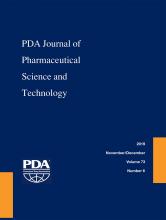Abstract
Container closure integrity (CCI) is one of the requirements for a sterile packaging system. For vial-based systems, the capping process is a critical step in creating and ensuring an adequate seal with acceptable CCI. Container closure integrity tests (CCITs) such as the dye ingress and the helium leak rate are two methods among many that, in the appropriate scenario, help to challenge this required attribute. The use of locked-in stopper compression (compression under the crimp seal post capping) enables correlation of these methods to CCI and seal quality. In fact, the overall acceptability of a seal can be evaluated using quantitative and qualitative methods. Usually lost in these assessments is the existence of seal cosmetics as an essential additional seal quality attribute. Unacceptable cosmetic quality can have a major impact on manufacturing (reduced batch output, high yield cost, etc.) and user (perceived low quality, brand image, potential injury, etc.) experiences. Interestingly, the aesthetics of a seal is also impacted by the capping process which is quite complicated because the acceptance criteria for aesthetics of a seal is subjective. Ultimately, this affects commercial manufacturing efficiency and CCI. Here, we present a simple methodology for package selection and evaluated multiple package configurations using locked-in stopper compression (through residual seal force, RSF) measurements and seal aesthetics analyses (using a semi-quantitative aesthetics scale). The integrity of the seals was analyzed using multiple CCIT methods. We determined that component dimensions such as the seal length play a major role in obtaining proper seal aesthetics and integrity. This can ultimately enable the selection of robust packaging components that provide an adequate range of manufacturing conditions without cosmetic defects. A failure to do this could result in high rejects during drug product visual inspection culminating in low batch yield, high costs or could pose harm to patients if suitable CCI is not achieved.
LAY ABSTRACT: One common container closure system for parenteral drug products includes a glass vial, rubber stopper, and aluminum crimp seal. The capping process, in which the elastomeric closure is compressed against the vial by means of an aluminum crimp seal, is key to ensuring an optimal seal from both an aesthetic and CCI perspective. Ensuring a robust capping process must include a deep and necessary understanding of the interconnection between the selected components, desired aesthetics of the seal, stopper compression, residual seal force, and CCI; the way in which the capper is configured (sealing parameters) will play a part in addition to the “style” used in manufacturing. Previous published studies have focused on capping process controls to only ensure CCI. Here, we present a useful methodology for selecting appropriate components and capping process parameters using a scaled-down approach to achieve elegant seal quality and CCI simultaneously. Dimensional analysis and capping design of experiments (DOEs) were conducted on lab-scale equipment that was representative of commercial configurations. The seals made from these studies were analyzed using residual seal force, helium leak, and dye ingress methods. The results and their implications were discussed with regard to the operating principle of the rail-type capping machine.
- © PDA, Inc. 2019
PDA members receive access to all articles published in the current year and previous volume year. Institutional subscribers received access to all content. Log in below to receive access to this article if you are either of these.
If you are neither or you are a PDA member trying to access an article outside of your membership license, then you must purchase access to this article (below). If you do not have a username or password for JPST, you will be required to create an account prior to purchasing.
Full issue PDFs are for PDA members only.
Note to pda.org users
The PDA and PDA bookstore websites (www.pda.org and www.pda.org/bookstore) are separate websites from the PDA JPST website. When you first join PDA, your initial UserID and Password are sent to HighWirePress to create your PDA JPST account. Subsequent UserrID and Password changes required at the PDA websites will not pass on to PDA JPST and vice versa. If you forget your PDA JPST UserID and/or Password, you can request help to retrieve UserID and reset Password below.






